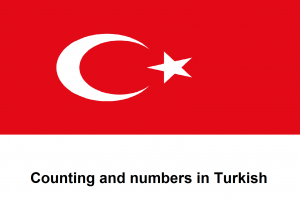Difference between revisions of "Language/Turkish/Vocabulary/Counting-and-Numbers"
| Line 16: | Line 16: | ||
!'''Number''' | !'''Number''' | ||
!'''türkçe''' | !'''türkçe''' | ||
|- | |||
|0 | |0 | ||
|sıfır | |sıfır | ||
Revision as of 20:45, 15 January 2022
Hello everybody,
In today's lesson you will learn ¨COUNTING AND NUMBERS¨ in Turkish.
Feel free to edit this page by adding new numbers and expressions!
Good learning! :)
Cardinal Numbers
| Number | türkçe |
|---|---|
| 0 | sıfır |
| 1 | bir |
| 2 | iki |
| 3 | üç |
| 4 | dört |
| 5 | beş |
| 6 | altı |
| 7 | yedi |
| 8 | sekiz |
| 9 | dokuz |
| 10 | on |
| 11 | onbir |
| 12 | oniki |
| 13 | onüç |
| 14 | ondört |
| 15 | onbeş |
| 16 | onaltı |
| 17 | onyedi |
| 18 | onsekiz |
| 19 | ondokuz |
| 20 | yirmi |
| 30 | otuz |
| 40 | kırk |
| 50 | elli |
| 60 | altmış |
| 70 | yetmiş |
| 80 | seksen |
| 90 | doksan |
| türkçe | |
| 100 | yüz |
| 1,000 | bin |
| 1,000,000 | milyon |
| 1,000,000,000 | milyar |
How to construct cardinal numbers
- 11 = 10 (on) + 1 (bir) = on bir
- 21 = 20 (yirmi) + 1 (bir) = yirmi bir
- 31 = 30 (otuz) + 1 (bir) = otuz bir
- 41 = 40 (kırk) + 1 (bir) = kırk bir
- 51 = 50 ( elli ) + 1 ( bir ) = elli bir
- 61 = 60 ( altmış ) + 1 ( bir ) = altmış bir
- 71 = 70 ( yetmiş ) + 1 ( bir ) = yetmiş bir
- 81 = 80 (seksen ) + 1 ( bir ) = seksen bir
- 91 = 90 (doksan ) + 1 ( bir ) = doksan bir
Ordinal Numbers
| English | Turkish | Transliteration in English |
| 1st | birinci | beer-EEN-jee |
| 2nd | ikinci | ee-KEEN-jee |
| 3rd | üçüncü | ur-CHURN-jur |
| 10th | onuncu | ohn-OON-joo |
| 20th | yirminci | yeer-MEEN-jee |
| 30th | otuzuncu | oh-tooz-OON-joo |
| 100th | yüzüncü | yurz-URN-jur |
| 157th | yüzelliyedinci | yurz-eh-lee-yeh-DEEN-jee |
| 1000th | bininci | been-EEN-jee |
| 1,000,000th | milyonuncu | meel-yohn-OON-joo |
Fractional Numbers
Prime numbers
WHAT IS A PRIME NUMBER?
Prime numbers are the set of natural numbers greater than 1 that are divisible by itself and 1 without a remainder. In other words, for a number to be a prime number, it must not be divisible by any number other than 1 that is less than itself.
HOW TO FIND A PRIME NUMBER?
First create a table.
All natural numbers from 1 to 100 are included in the table you created.
Mark the multiples of two and three.
Cross out multiples of all numbers as the numbers go up.
Cross out the 2, known as the smallest of the prime numbers.
After these operations, you will have found all the remaining prime numbers.
WHAT ARE 2 DIGITS PRIME NUMBERS?
11, 13, 17, 19, 23, 29, 31, 37, 41, 43, 47, 53, 59, 61, 67, 71, 73, 79, 83, 89 ve 97.
WHAT ARE 3 DIGITS PRIME NUMBERS?
103, 107, 109, 113, 127, 131, 137, 139, 149, 151, 157, 163, 167, 173, 179, 181, 191, 193, 197, 199, 211, 223, 227, 229, 233, 239, 241, 251, 257, 263, 269, 271, 277, 281, 283, 293, 307, 311, 313, 317, 331, 337, 347, 349, 353, 359, 367, 373, 379, 383, 389, 397, 401, 409, 419, 421, 431, 433, 439, 443, 449, 457, 461, 463, 467, 479, 487, 491, 499, 503, 509, 521, 523, 541, 547, 557, 563, 569, 571, 577, 587, 593, 599, 601, 607, 613, 617, 619, 631, 641, 643, 647, 653, 659, 661, 673, 677, 683, 691, 701, 709, 719, 727, 733, 739, 743, 751, 757, 761, 769, 773, 787, 797, 809, 811, 821, 823, 827, 829, 839, 853, 857, 859, 863, 877, 881, 883, 887, 907, 911, 919, 929, 937, 941, 947, 953, 967, 971'dir.
